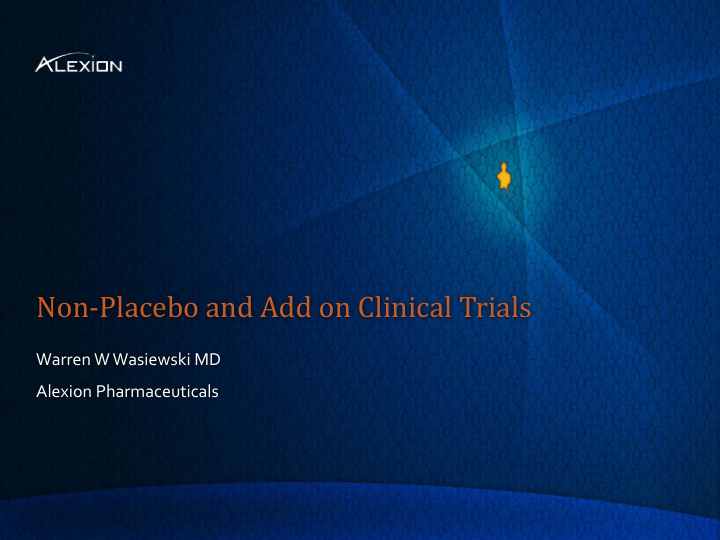



Non-Placebo and Add on Clinical Trials Warren W Wasiewski MD Alexion Pharmaceuticals
Present state of the Art • All treatments are considered “empiric” • There are no completed randomized double blind placebo controlled trials • Retrospective review indicates empiric therapy reduces ARR • There remains an unmet medical need 2
Study Designs • Add-on to current therapy ○ Permits background ISTs • Active comparator ○ Any comparator at any dose ○ Single specified comparator with fixed dose ○ Single medication or combination • Randomized withdrawal ○ Withdraw ISTs within study • Historical Control group 3
Add-on Trial Design • Experimental treatment is add-on to background “empiric” therapy ○ Stable maintenance dose of any empiric therapy or combination ▪ Azathioprine plus steroids ○ Fixed dose of a single specific empiric therapy ▪ e.g. Azathioprine ○ Specific empiric therapy with no dose restriction 4
Add-on Trial Design Pros : ○ May reduce risk of relapse by allowing empiric therapy in the placebo arm ○ No need to withdraw current therapy ○ Establishes that the treatment is better than present treatments ○ Defines the treatment effect of empiric therapy in the placebo arm 5
Add-on Trial Design Cons: ○ “Unwarranted attribution of benefit to combined treatment” ○ May be difficult to establish the treatment effect of the new therapy if it is not robust ○ Patients may have already failed several empiric therapies ▪ Enrollment issues and restarting prior failed medication ○ May increase the number of attacks needed to show efficacy compared to a placebo only design ○ Additional safety risk 6
Add-on Trial Design Efficacy Assessment: • Can the effect of the new treatment be clearly defined? • Is the treatment effect dependent on the presence of other treatments? • Is the treatment effect only present with one type of concomitant medication? • Is there an additive treatment effect? 7
Time to first Relapse Drug A plus SOC Placebo plus SOC Time (days) 8
Add-on Therapy Sensitivity analysis ○ Compare subgroups ▪ For each empiric therapy ▫ i.e. AZA +A vs AZA + placebo ▫ For combinations of empiric therapies ○ If treatment effect is robust sensitivity analyses have the potential to determine if the effect is due to the combination or is independent ○ Group size may limit interpretation due power considerations 9
Time to first Relapse Drug A plus AZA Placebo plus AZA Time (days) 10
Add-on Trial Design Safety Assessment :Additive toxicity ○ Related to MOA of both treatments and off target toxicity ○ May require more robust safety monitoring ○ Pharmacokinetic and Pharmacodynamic interactions • Mitigated by ○ Understanding the safety profile of both agents ○ Enhanced safety monitoring ○ Defining adverse events of special interest ○ Unblinded safety review by DMC ○ Assessment of PK and PD with other treatments 11
Comparator Trial Design Why compare to an unproven therapy ? • Comparator must be established to be better than placebo ○ There is no comparator that meets this criteria • Superiority trial needed • Annualized relapse rates are not firmly established for empiric therapies • Only compares to one treatment regiment : regional differences • Worsening caused by one therapy may be interpreted as efficacy of the other treatment 12
Withdrawal Trial Design • Initiate treatment with experimental compound as add on to existing therapy • Active and Placebo groups ○ Stable background treatment ○ Prescribed stable background treatment of single medication ○ Combination treatments • Withdraw empiric therapy at specified time ,over specified time interval 13
Withdrawal Trial Design • Pros ○ Mechanism to withdraw in a controlled manner • Cons ○ Unclear how long the effect of empiric therapy persists ○ May place both groups at risk of relapse ▪ Due to withdrawal ○ What is the risk of relapse in this clinical scenario ▪ No data to power study 14
Historical Control Trial Design • The understanding of Neuromyelitis Optica has evolved significantly • Discovery of AQ4P antibody • Time to diagnosis has shortened dramatically ▪ 12.4 years prior to 2004 to 0.1 years 2009 * • New Diagnostic Criteria have been proposed several times since 1999 • Some prior empiric treatments are now known to be detrimental * Tackley G et. al. ECTRIMS 2014 15
Historical Controls • Defining the appropriate historical control group would be difficult • Need to match on several characteristics ○ Gender ○ Race ○ Age of onset of first attack ○ Serotype ○ Onset attack phenotype (i.e. type of onset attack) ○ Untreated ARR ○ Regional standards of care 16
Placebo Only Trial Design Active drug vs. Placebo only • Cleanest Design • There are risks to the patient ○ What is the incidence of relapse in this clinical scenario • Enrollment may be difficult • Mitigation strategies to reduce risk are not adequate ○ Reducing time on placebo ▪ Increases total number of relapses ○ Liberal escape clause 17
Placebo Only Trials ○ Recent data show attacks off treatment are more likely to result in significant deficits Transverse Myelitis Off Treatment On Treatment n=24 n=12 Change in EDMUS score mean(SD) 3 (3.17) 0.21 (3.12) P< 0.05 % no residual change 33.3 50 * Tackley G et. al. ECTRIMS 2014 18
Add-on Study Trial Design • Offers some degree of protection against relapse to the placebo treated patients ○ SOC • Permits comparison to empiric therapies not just placebo • No need to withdraw relapsing patients from current therapy • If the treatment effect is robust , transformative ○ Sensitivity analyses have the potential to determine if the effect is due to the combination or is independent • Patients may see this option as more acceptable 19
QUESTIONS 20
Recommend
More recommend